‘Everything is Connected’ – Laudato Si’ Week 2020
May 20, 2020This week (16-24 May), we celebrate the fifth anniversary of Laudato Si’, the amazing and life changing encyclical by Pope Francis.
This revolutionary document calls us, as Catherine Shelton rsj so succinctly states:
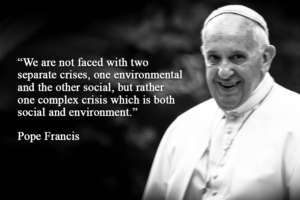 Pope Francis summons us, both to a deep and profound care for earth, and to a clearer recognition of the challenges facing earth and all of creation. He reminds us, in the theme of this week, that “everything is connected”.
Pope Francis summons us, both to a deep and profound care for earth, and to a clearer recognition of the challenges facing earth and all of creation. He reminds us, in the theme of this week, that “everything is connected”.
Both Pope Francis and Bishop Long offer reflections (provided below) that call us to a new place. You are invited to share these with families and communities, as we consider once again the gift and challenges of this time.
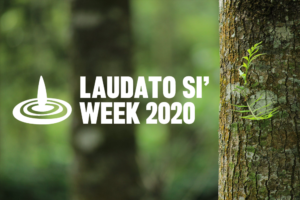 The confluence of recent events – the young people’s climate strike (School Strike 4 Climate) on Friday 15 May, the tragedy of the summer bushfires across Australia, the impact of COVID-19 – all of these can only strengthen the call of this encyclical, articulated by these two inspiring church leaders, to care more deliberately for earth and the common good.
The confluence of recent events – the young people’s climate strike (School Strike 4 Climate) on Friday 15 May, the tragedy of the summer bushfires across Australia, the impact of COVID-19 – all of these can only strengthen the call of this encyclical, articulated by these two inspiring church leaders, to care more deliberately for earth and the common good.
You might also find some of the following resources helpful:
- Overview of Laudato Si’ by Neil Darragh, indicating the concerns, the care, and the change the Pope hopes for. (online here)
- LCWR‘s most recent Resolution to Action (vol. 24 no.3): ‘Climate: A Common Good’ (click here)
- Leonardo Boff – The Magna Carta of integral ecology: cry of the Earth-cry of the poor
- Laudato Si’: Caring for our Common Home Discussion Guide – for small groups to explore and dialogue with this important document. Prepared by USCCB Justice Peace and Human Development. English (click here)
Jan Barnett rsj
Josephite Justice Coordinator
Pope Francis invites the Church to celebrate Laudato Si’ Week
Message for the Fifth Anniversary of Laudato Si (Bishop Vincent Long | Chair, Bishops Commission for Social Justice – Mission and Service)
Images:
Pope Francis obtained from pxhere. Used with permission.
Brown Tree Trunk by Mahima obtained from Pexels. Used with permission.
One Hundred Years in Albert Street
One hundred years ago this Friday, on Saturday 15 May 1920, additions to St Joseph’s Providence in Albert Street East Melbourne were blessed and opened by His Grace the Archbishop of Melbourne, the Most Reverend Dr Daniel Mannix.
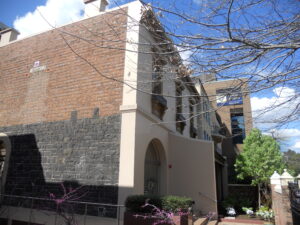 To meet the need for etended accommodation at St Joseph’s Providence in East Melbourne the Sisters of St Joseph purchased the two-storey residence adjoining the Providence. The property was built as a townhouse and owned by Dr and Mrs Howitt.
To meet the need for etended accommodation at St Joseph’s Providence in East Melbourne the Sisters of St Joseph purchased the two-storey residence adjoining the Providence. The property was built as a townhouse and owned by Dr and Mrs Howitt.
After officiating at the blessing and opening of the additions to St Joseph’s Providence, His Grace then opened a fete in the grounds of St Patrick’s College, East Melbourne in aid of the ‘Home’, which was to become known as St Joseph’s Hostel for the next sixty plus years. In addition to His Grace the Archbishop of Melbourne, who was about to set sail on a visit to the “old countries”, others present included the Bishop of Sale, the Right Reverend Dr Phelan, the Bishop of Ballarat, the Right Reverend Dr Foley and the Administrator of the Bendigo Diocese, the Very Reverend Dean Rooney. A guard of honour was provided by the children attending the schools conducted by the Sisters of St Joseph. It was quite an occasion.
The Advocate reported that in declaring the Fete open, Archbishop Mannix said he was “always glad to do whatever he could for the Sisters of St Joseph.” Furthermore, he “would not fail to tell the people on the other side of the world that the Australian Sisterhood of St Joseph were the equals of any Sisters in the whole of the Catholic world.”
According to the report, the fete had been organised to assist the Sisters in “carrying on” their Home for girls desiring to live with them, in preference to going into ordinary boarding houses in Melbourne. It was a very necessary provision and was deserving of generous support.
The Garland of St Joseph dated 1 July 1920 noted that the Mother-General of the St Joseph Order was present at the blessing of the additions to St Joseph’s Providence, East Melbourne on Saturday 15 May. She was making her annual visit from Mount Street, North Sydney.
Today, a century later, the former townhouse and hostel is part of the Mary MacKillop Heritage Centre and home to the O’Callaghan Community. We hope to celebrate this special anniversary at the Mary MacKillop Heritage Centre with the residents of the O’Callaghan Community later in 2020.
Garry McLean, CEO
LLoyd Fisk, Archivist,
Mary MacKillop Heritage Centre
Media Release: CERA
May 18, 2020Catholic Emergency Relief Australia (CERA) has opened an initial grant application round to support those continuing the long process of recovery from the summer’s catastrophic bushfire season.
CERA chair Susan Pascoe said while the country “is largely – and understandably – focused on the COVID-19 pandemic”, challenges like social isolation and financial hardship are exacerbating some problems the bushfires caused…
You’re invited to continue reading the Media Release, view the grant application form and visit the CERA website below:
Media Release: Grant Applications Opened for Ongoing Bushfire Recovery (PDF)
National Volunteers Week 2020
Volunteering at Mary MacKillop Place, Mount Street, North Sydney.
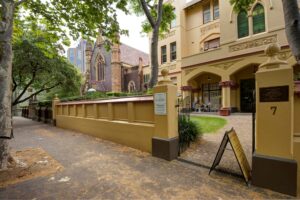
Arriving at the Business Centre of North Sydney the scene is one of a busy working environment. Cars, buses and people going many ways to engage in their daily duties to serve the community. A short walk up the hill of Mount Street we arrive at Mary MacKillop Place.
We have come upon a quiet place in a busy environment. The Museum offers visitors the opportunity to learn about the life and work of Australia’s first Saint, Mary MacKillop and Father Julian Tenison Woods, who along with Mary co-founded the religious order of the Sisters of Saint Joseph. The story of Mary’s work in founding a religious order in Australia outlines the many qualities that give people hope in today’s world. Mary showed great faith, courage, perseverance, loyalty and dedication to a worthy cause as she encountered many obstacles and even rejection of her vision for the future.
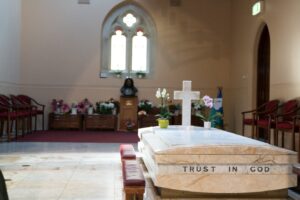
A visit to the Mary MacKillop Memorial Chapel is an experience of calm and peace. Many visitors come each day to this sacred place of prayer and pilgrimage –some as tourists from overseas, others to ask for help through Mary’s intercession for the needs in their lives. The tomb of Saint Mary MacKillop is present in the chapel and patrons can kneel and pray in the peace of God’s presence.
As a volunteer in both the Museum and the Chapel, I enjoy sharing the story of how Mary achieved her vision with the help of Julian and letting others know that it was Mary’s trust in God that kept her strong. There are over 100 volunteers at Mary MacKillop Place, and we work in many different areas of the complex. As well as being tour guides in the Museum, others volunteer in the Café and Gift Shop assisting with the preparation of food and coffee and serving tables. Some volunteers help in the Chapel where they provide a ministry of listening for people who wish to share their stories or who are seeking prayers through the intercession of Mary MacKillop. Volunteers also assist in administrative tasks, IT, marking and sorting stock for the Café and many other miscellaneous tasks.
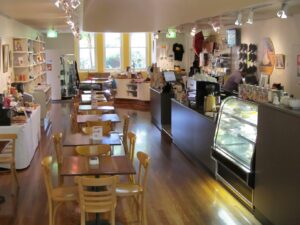
I became a volunteer because I wanted others to be aware of the great work of our first Australian Saint and to let people know how the virtues of Mary MacKillop can help us find peace in living our lives. With a large group of volunteers, we have the opportunity to form friendships and exchange information which helps us fulfill our roles. Mary MacKillop Place is certainly a place of peace and tranquility and along with all the other volunteers it is my privilege to be able to contribute to keeping the legacy of Mary MacKillop and the Sisters alive in today’s world. Unfortunately during this Coronavirus Pandemic we are unable to perform our usual duties, but are grateful to be kept connected through regular inspirational messages being sent to all the volunteers.
Beverley Badcock
In the Steps of Borrowed Shoes
May 15, 2020For International Day of Families this year, our author focused on how at a time of great exclusion, the Sisters made an indigenous girl captain of the school debating team, and in their borrowed shoes, they won.
This is a memory, not a history. For over half a century I thought this story belonged to the Sisters of Saint Joseph in Brisbane. Three days ago, when I tried to Google to find more information about the school, I began to wonder if it was staffed by another order. I was only ten, or younger.
But I write fiction as well as history. Sometimes it is easier to explain the truth in a novel, when you don’t have enough facts to say, ‘it happened just like this.’ Since I was that small child, the Sisters of Saint Joseph have been my guide and inspiration. Today I realised that even if my memory is faulty, this story still belongs to the Sisters of Saint Joseph, whichever genre it might be catalogued in.
One definite memory: Mum drinking tea in a staff room with the Sisters in brown habits, the tea in thick blue cups, strong enough to melt the spoon. Suddenly one of the Sisters glanced out the window. She raced outside to the bare playground and grabbed the two boys fighting by their collars, then held them apart. No belting, just a lecture. By the end they looked ashamed.
‘ Sorry, Sister,’ they said as they shook hands.
Sorry, Sister,’ they said as they shook hands.
Most Saturday afternoons our family took afternoon tea at Stuartholme, a school on the foothills where Dad taught debating. I loved the silent cloisters, the tree filled gardens, the vast floor to ceiling books where I learned the riches of history. The tea was served in thin china teacups. The quiet conversation was not interrupted by kids yelling outside.
Mum taught debating at the other school. In the other schools where Mum and Dad taught debating, the parents paid for it as an ‘extra’, like music or Art of Speech. At that school the Sisters had somehow found enough money for everyone to learn. Debating – finding the right words and best arguments to support your beliefs – might be a route to whatever life the students dreamed of, from an apprentice to university or prime minister.
 Few girls debated in early 1960’s, but it seemed no one had thought to make rules to say they weren’t allowed to. There were no rules excluding indigenous students either, just lots of excuses to kick them out. But those Sisters made an indigenous girl Captain of their school debating team. They borrowed shoes for the team too.
Few girls debated in early 1960’s, but it seemed no one had thought to make rules to say they weren’t allowed to. There were no rules excluding indigenous students either, just lots of excuses to kick them out. But those Sisters made an indigenous girl Captain of their school debating team. They borrowed shoes for the team too.
Mum came home laughing after that first debate. The team had been nervous, barely articulate. But something had been wrong with the other team. The ‘impossible’ team had won.
That win gave them confidence. They deserved their win in the next debate, and the next. By the end of that year, they won the championship.
I am only one of those who has tried to follow in the footsteps of those borrowed shoes.
Jackie French
Photo: People Forming Round by Shoes by Ingo Joseph obtained from Pexels. Used with permission.
Photo: People Looking at Laptop Computer by Fox from Pexels. Used with permission.
Laudato Si’ Webinar: Part Two
May 14, 2020In May 2015 Pope Francis launched his encyclical with the subtitle “On Care for our Common Home” and the title “Laudato Si’” which are the opening words for a hymn composed by St Francis of Assisi in the 1200s.
For our time, this document is both relevant and important, since it highlights the priority that respect for the environment should have in Catholic life, and integrates the notion with what is central to our understanding of humanity’s relationship with God.
Help floods in after Sister’s sailors SOS
May 13, 2020An overwhelming response to seafarers’ appeal is sweet.
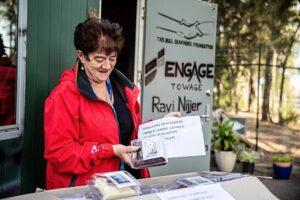
Donations from across the country and gratitude from around the world have been flooding in for the tireless work being done by a Sydney religious sister supporting the seafarers visiting our shores.
Known as the “angel of the waterfront”, Sister Mary Leahy has spent the past 20 years helping those who earn a living on the seas and said she has never seen conditions so desperate.
Trapped on what has been described as “floating prisons”, many of the world’s 1.6 million seafarers already at sea for up to nine months have no real sign of when they will be able to return home due to the COVID-19 pandemic.
The quietly spoken Josephite sister issued an urgent appeal for personal hygiene products including shampoo, body wash, toothpaste, deodorant and razors, as well as knitted beanies and chocolates to put together care packages for the sailors, and admits to being overwhelmed by the huge response.
However, it’s the messages of gratitude from the exhausted seafarers globally that has made her even more committed to providing not only practical but spiritual support at this time of great need…
You’re invited to continue reading on The Catholic Weekly website below:
Click here to continue reading
Debbie Cramsie
The Catholic Weekly
So Small a Beginning: Part 2
May 8, 2020Sr Marie Foale speaks about the beginnings of the Institute of St Joseph for the Catholic education of poor children.
She believes that as a young Josephite growing up, she had a sense that one day Mary MacKillop and Julian Tenison Woods had made a spontaneous decision to found an order.
